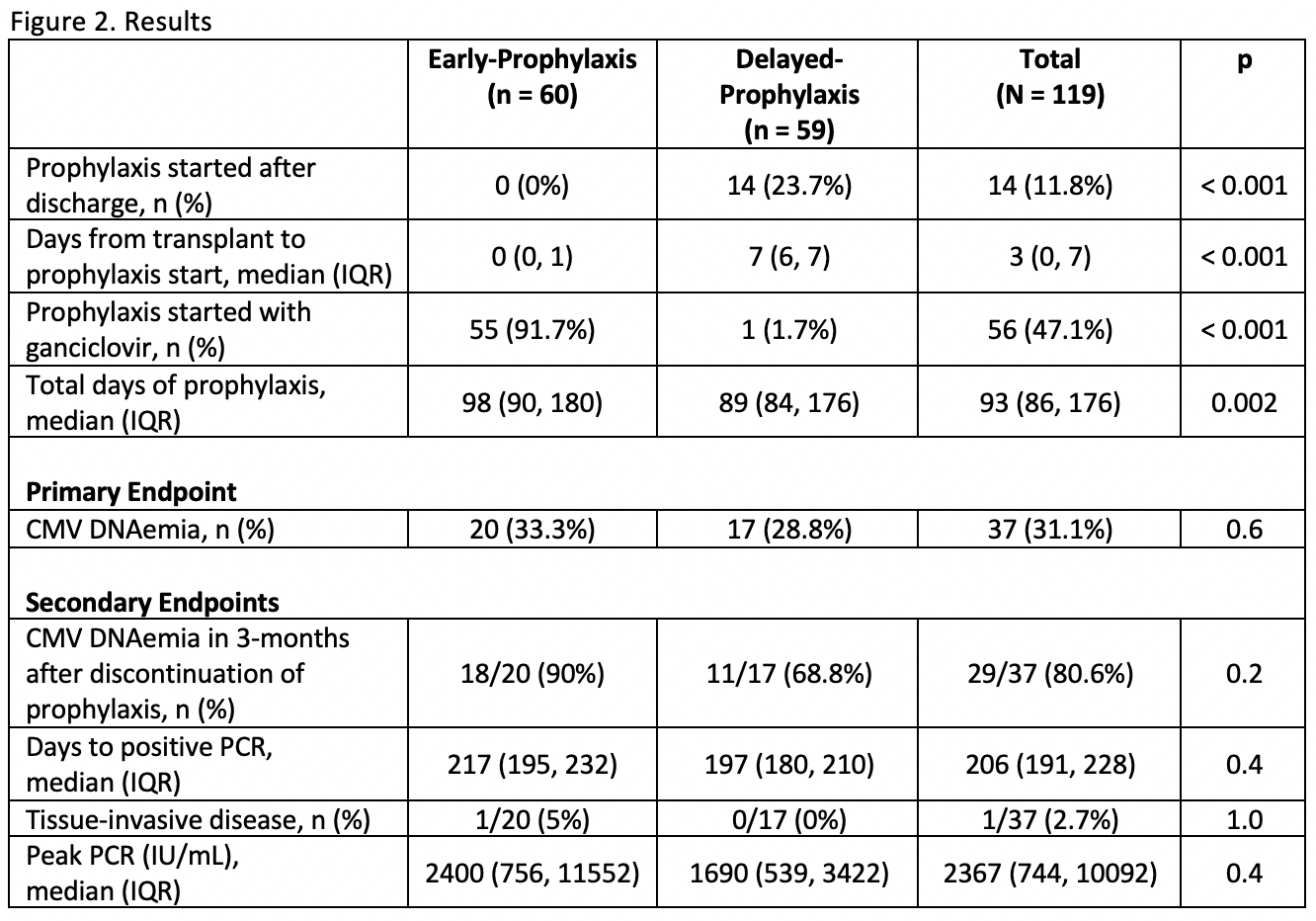Early versus Delayed Initiation of CMV Prophylaxis after Liver Transplantation
M. Magid, J. Byrns, J. Gommer, Z. Yang, M. Harris
Duke University Hospital, Durham, NC
Meeting: 2020 American Transplant Congress
Abstract number: A-177
Keywords: Cytomeglovirus, Infection, Liver transplantation, Prophylaxis
Session Information
Session Name: Poster Session A: All Infections (Excluding Kidney & Viral Hepatitis)
Session Type: Poster Session
Date: Saturday, May 30, 2020
Session Time: 3:15pm-4:00pm
 Presentation Time: 3:30pm-4:00pm
Presentation Time: 3:30pm-4:00pm
Location: Virtual
*Purpose: To determine the incidence of CMV DNAemia in early (prior to post-op day 7) versus delayed prophylaxis in liver transplant recipients.
*Methods: Retrospective, single-center study of adult liver recipients transplanted between 2/1/17-2/28/19 who were CMV high (D+/R-) or intermediate-risk (R+). Early prophylaxis was defined as initiation prior to post-op day 7, and delayed prophylaxis included those who initiated prophylaxis on post-op day 7 or after. High-risk patients received 6 months of prophylaxis and intermediate-risk received 3 months. The standard of care for immunosuppression included methylprednisolone induction with tacrolimus, mycophenolate, and prednisone. The primary endpoint was the incidence of CMV DNAemia between groups. Secondary endpoints included peak quantifiable viral load, time to detection, and incidence of tissue invasive disease. Multivariable logistic regression was utilized to explore if timing of prophylaxis impacted CMV DNAemia.
*Results: 119 patients (n = 60 in early and n = 59 in delayed) were included and baseline demographics were similar except for gender (see Figure 1). Twenty (33.3%) patients in the early group and 17 (28.8%) in the delayed group developed CMV DNAemia within 9-months of transplant (p = 0.6). The median time from transplant to the first positive PCR was 217 days and 197 days in the early and delayed groups, resp (p = 0.4). Initial DNAemia detection occurred within 3-months following discontinuation of prophylaxis in 81% of patients. The remainder of CMV DNAemia was detected later than 3-months post-transplant with the exception of two patients who had positive titers while on prophylaxis (see Figure 2). When adjusting for other covariates, timing of prophylaxis did not have an impact of CMV DNAemia with an OR of 1.1 (95% CI [0.4, 2.8], p = 0.9)
*Conclusions: In this cohort, no difference was seen in the incidence of CMV DNAemia within 9-months of liver transplant or 3-months following discontinuation of CMV prophylaxis between patients started on CMV prophylaxis before or after post-op day seven. Additionally, there was no difference seen in time to detection, peak CMV DNAemia, or incidence of CMV tissue invasive disease. Delaying prophylaxis may limit side effects during the early post-op period and be cost-saving.
To cite this abstract in AMA style:
Magid M, Byrns J, Gommer J, Yang Z, Harris M. Early versus Delayed Initiation of CMV Prophylaxis after Liver Transplantation [abstract]. Am J Transplant. 2020; 20 (suppl 3). https://atcmeetingabstracts.com/abstract/early-versus-delayed-initiation-of-cmv-prophylaxis-after-liver-transplantation/. Accessed January 6, 2026.« Back to 2020 American Transplant Congress


